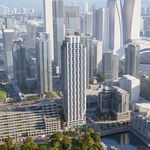All you have to do is paste the link.
Awesome news!
To imbed a tweet, click insert > media and paste the link there

Argh, I work in tech and I give up! I was using the embed link function from twitter and didn't copy the text. It's messy but at least it works.
Funt fact!
With service starting on June 21, 2019 this means that the LRT will launch almost 10 years to the day when council approved moving forward with LRT. It's a shame that launch of service was only off by 5 years form the original 2014 prediction.
Council votes 15-1 in favour of bringing electric trains to region
June 25, 2009
FRANCES BARRICK
RECORD STAFF
WATERLOO REGION
Waterloo Region last night approved a $790-million light rail transit plan that includes electric trains for Kitchener-Waterloo and fast buses for Cambridge.
"This is a historic moment," said Coun. Jim Wideman of Kitchener.
Rail transit could be launched by 2014 in Kitchener and Waterloo, if federal and provincial funding pays for most of the construction costs. Fast buses could be launched by 2011 in Cambridge.
But a seven-part recorded vote reopened festering animosities between northern and southern parts of the region.
"This is a historic moment, but it depends on what side of the 401 you live on," said Cambridge Mayor Doug Craig. "What we really have is a Kitchener-Waterloo light rail plan."
While Craig was the only councillor who voted against approving light rail transit as the preferred option for the region, he was joined by two regional councillors from Cambridge and North Dumfries Mayor Kim Denouden in voting against the staging of the project, which would see Cambridge getting fast buses and Kitchener-Waterloo electric trains.
"The citizens of Cambridge are being shafted," Craig said.
Craig vowed to ensure the senior governments know Cambridge residents feel like second-class citizens.
And in a later interview, Craig said Cambridge council is considering appealing the region's environmental assessment study, that sets the stage for light rail transit, to the Ontario Minister of the Environment.
He wanted regional council to defer a decision until a consensus is formed on the issue between the region's seven mayors and the regional chair.
"I am not sabotaging it," he said of the project. "Cambridge has a position that it wants to be treated fairly and equitably."
The Cambridge mayor said he is going to ensure that the federal and provincial governments know about a study his city commissioned that says planners understated rapid buses for the region and overstated electric trains.
Craig believes rapid buses could serve the region for the next 30 years at a lower cost of $585 million.
Planners say extending electric trains to Cambridge would cost another $583 million.
Ridership in Cambridge is projected to be much lower, and there is less potential to attract development by the tracks.
Regional Chair Ken Seiling said in an interview that he takes exception to the idea that Cambridge is being left out.
"I would be disappointed if he (Craig) tried to sabotage the project for the region," Seiling said.
He called last night's vote a "first step," as the project is conditional on funding from the senior governments.
The province has pledged to pay up to two-thirds of rapid transit costs, but Premier Dalton McGuinty said the legislature must agree the project is appropriate.
Seiling said the federal government has provided one-third funding for similar projects in the Greater Toronto Area, and he expects the region will be treated equally.
During last night's three-hour debate, many councillors hailed the decision as one that will transform the region from a sprawling community dependent on vehicles to one that is more compact as it draws residents and jobs to urban neighbourhoods.
"What we are doing is building our community for future generations," said Kitchener Mayor Carl Zehr.
"I expect to look back at this day as a bold, visionary decision that was made for the benefit of all residents," Zehr said.
"This is a decision for our children and grandchildren," Seiling added.
Wideman said without light rail transit, the region would need 100 lanes of road -- the equivalent of 16 Conestoga Parkways -- to accommodate the expected population growth over the next three decades. With rapid transit, only 34 lanes of roads would be needed.
He said his dream would be to have electric trains throughout the region, but that is not realistic.
Coun. Claudette Millar of Cambridge said her wish is for the shovel go in the ground for the trains in the south on the same day the first train goes on the track in the north.
Coun. Sean Strickland of Waterloo said he envisions a day when he can travel from his home in north Waterloo to downtown Toronto, first by electric train and than GO train, rather than battling the Highway 401 traffic.
"It is time to move into the future with light rail transit," he said.
Council has pursued rail transit since 2002, pitching it as a reurbanization scheme to draw jobs and homes to neighbourhoods near the stations, instead of building more roads. The region's population is slated to be 729,000 by 2031.
Critics fear it will be a costly white elephant, failing to draw enough passengers or buildings in a community where the vast majority of people drive.
Supporters say it will put an extra 13,068 residents into neighbourhoods near the stations, along with an extra 18,784 jobs.
It will also reduce greenhouse gases by 14,030 tonnes, save 18,512 minutes in travel time during the morning rush, and increase land values near stations by $215 million.
Councillors have been warned that regional taxes may rise by three per cent to pay for rapid transit's annual operating costs.
Council has also been asked to spend $10 million over 10 years on incentives to boost ridership and redevelopment in Cambridge.
fbarrick@therecord.com
RAPID TRANSIT TIMELINE
1999: Regional council rejects rapid transit until after 2016. Planners cite few projected passengers.
2002: Council revives rapid transit, recasting it as a reurbanization scheme. Politicians propose spending $260 million on electric trains in Kitchener and Waterloo. A convention centre in downtown Kitchener is included. Senior governments are asked to fund it.
2003: Council refines the rapid transit proposal, shedding the convention centre and other add-ons.
Council makes rapid transit a central feature of a landmark strategy to manage growth until 2041.
2004: Senior governments refuse to fund rapid transit but agree to help pay for two more studies.
2005: A federal study finds rapid buses costing $112 million are the best value for moving people. But trains are favoured at $306 million because they are more likely to attract redevelopment. Council launches another, bigger study to assess rapid transit. It considers a range of technologies, including a subway and monorail.
2006: Ontario enacts legislation requiring this region to become more compact. Politicians are directed to plan for a population of 729,000 by 2031.
2007: Planners narrow options to rapid buses or electric trains.
Province declares: "The government of Ontario will fund up to two-thirds of the project costs for Kitchener-Waterloo's rapid transit plan."
2008: Planners unveil a short list of possible routes for rapid buses and electric trains. Senior governments announce an infrastructure fund and declare: "The governments of Canada and Ontario also identified ... rapid transit in Kitchener-Waterloo as initial priorities that the two governments will work together on under Building Canada."
May, 2009: Planners propose to launch electric trains in Kitchener and Waterloo and fast buses in Cambridge, pending funding from senior governments. Estimated costs escalate to $790-million due to construction inflation, three kilometres in extra length, and project additions.
June 24, 2009: Council votes on rapid transit proposal, in order to seek provincial approval and funding from senior governments.
NEXT STEPS
Summer 2009: Proposal finalized, sent to the Ontario government for approval. Federal and provincial governments pressed for funding. Regional council reviews proposal in light of funding commitment.
By December 2009: Final version of proposal sent to Ontario government for funding approval.
2010-11: Cambridge gets fast buses.
2010: Final design of the rail transit system.
Late 2011: Construction contract expected to be awarded.
2012-14: Construction.
Late 2014: Opening day for electric trains.





